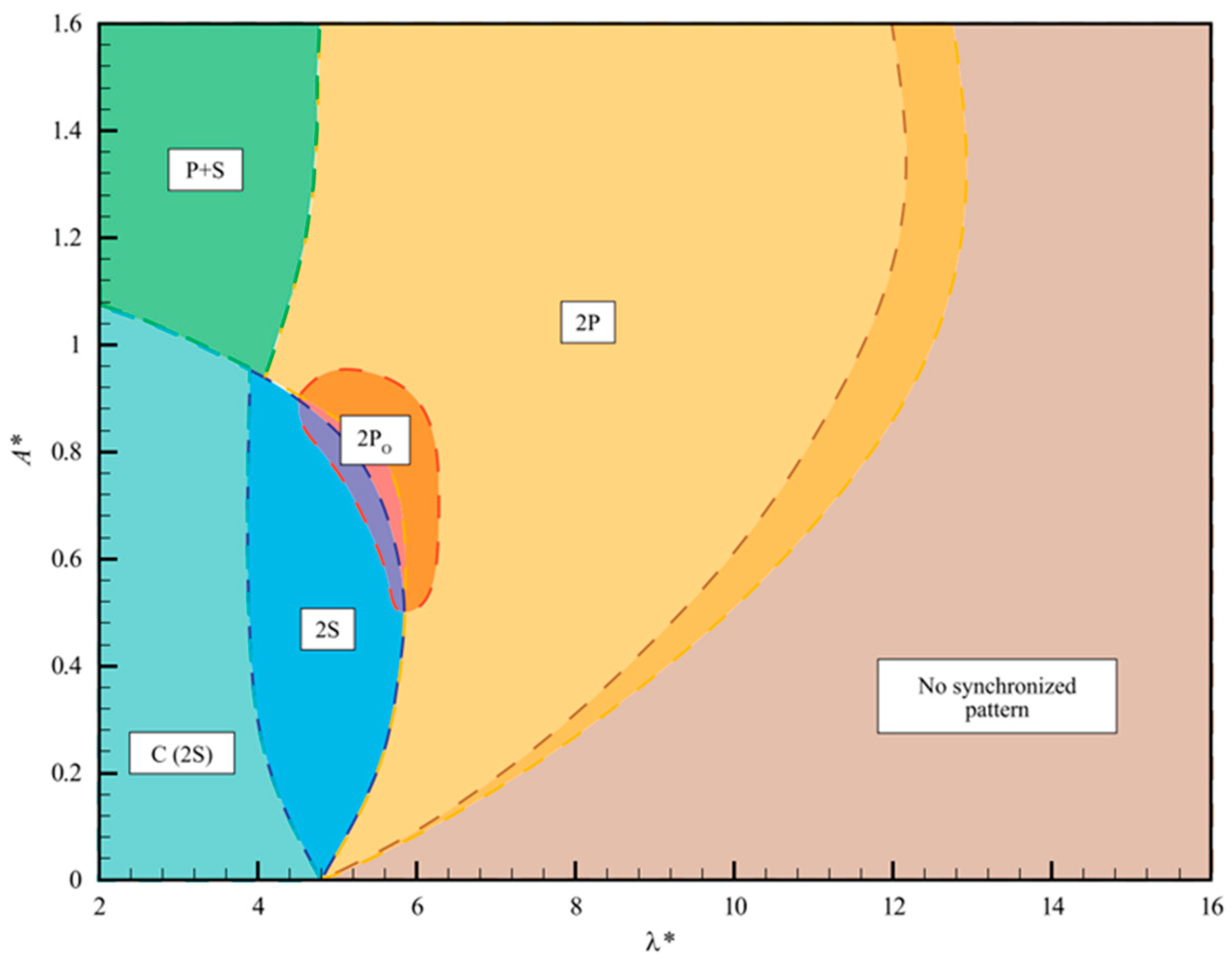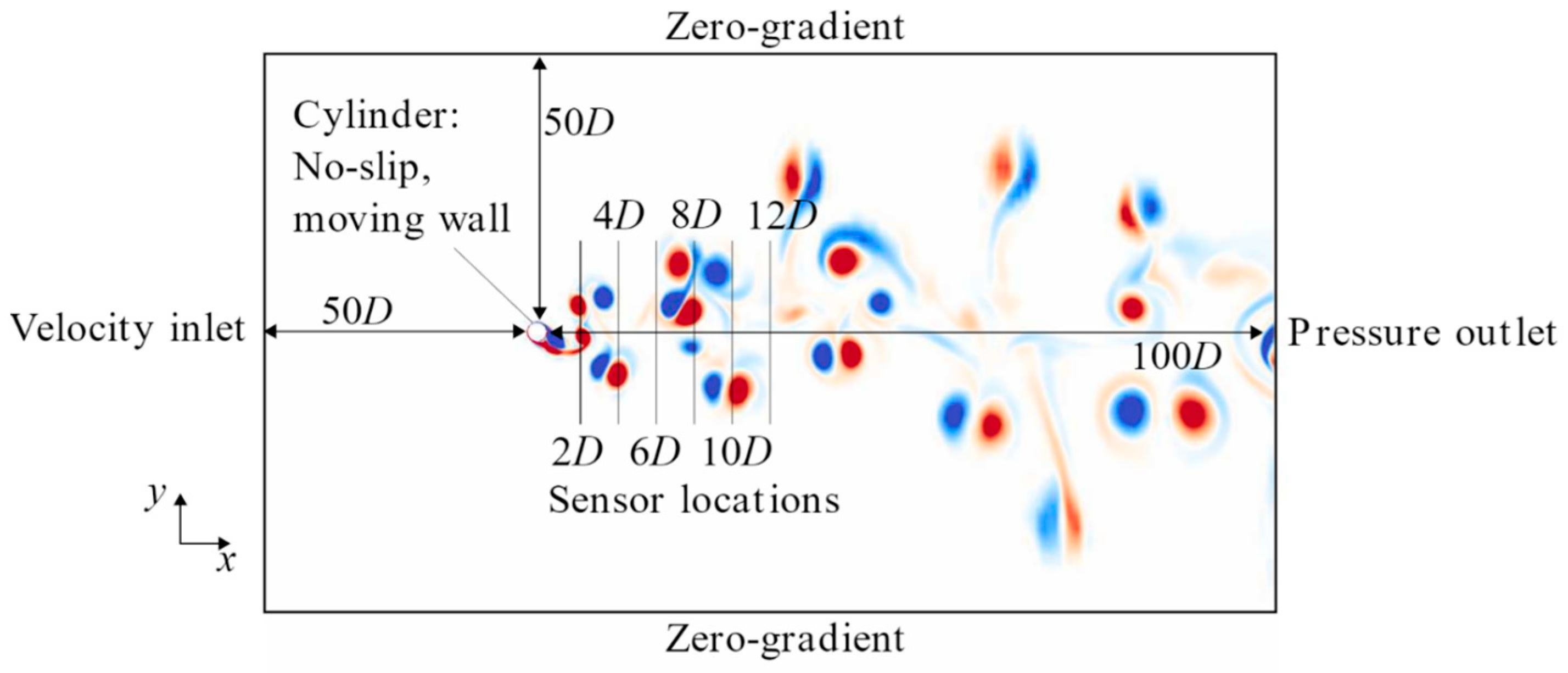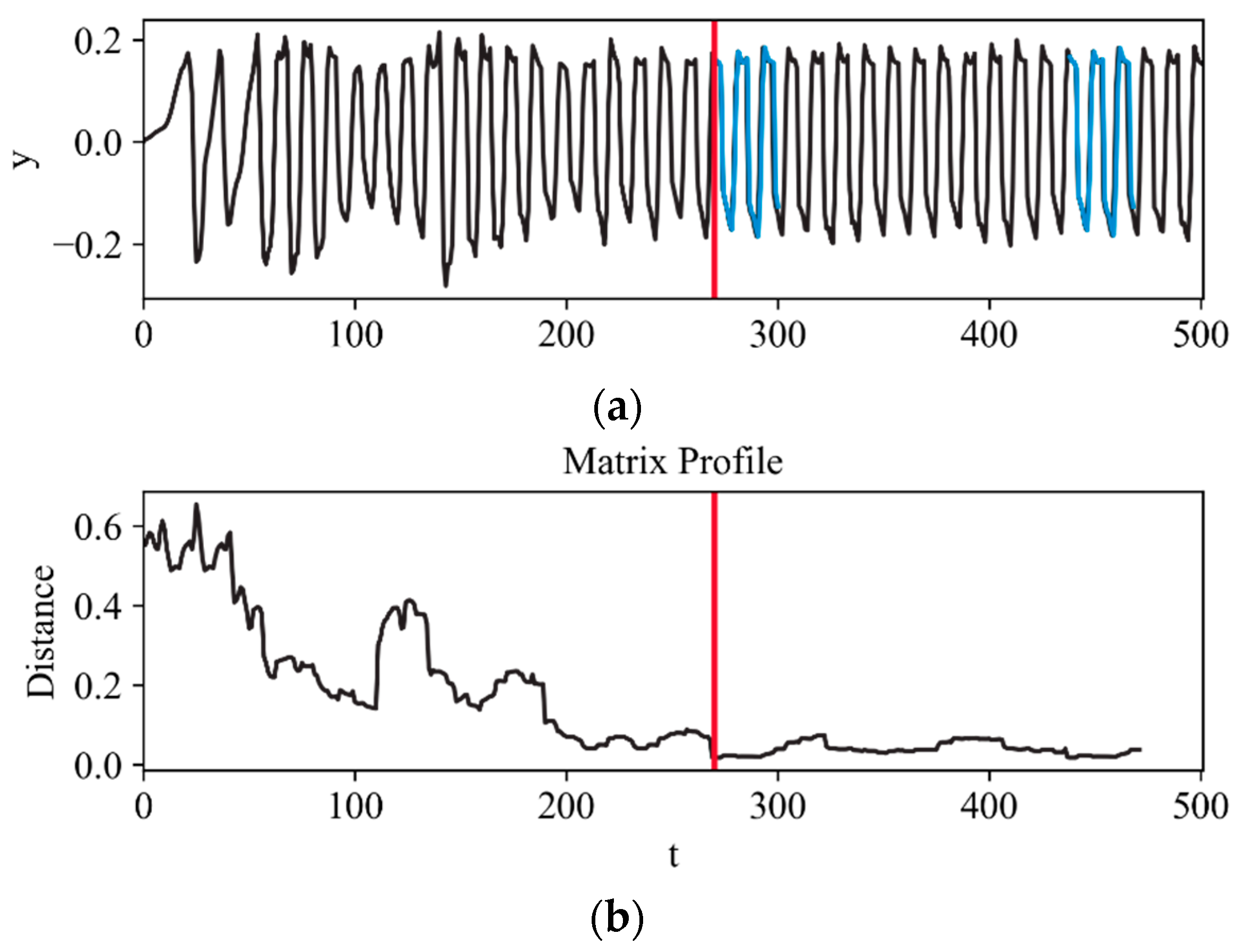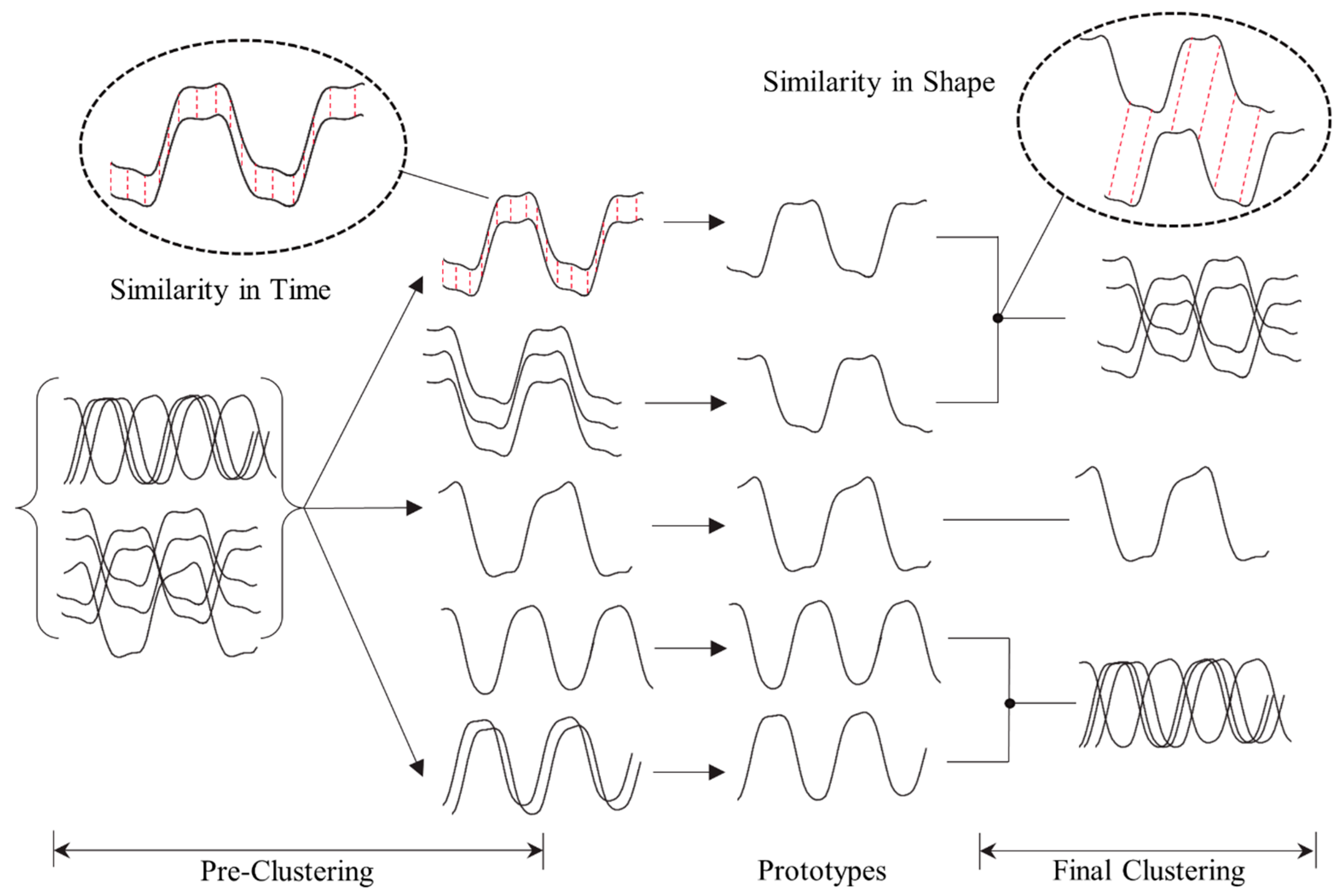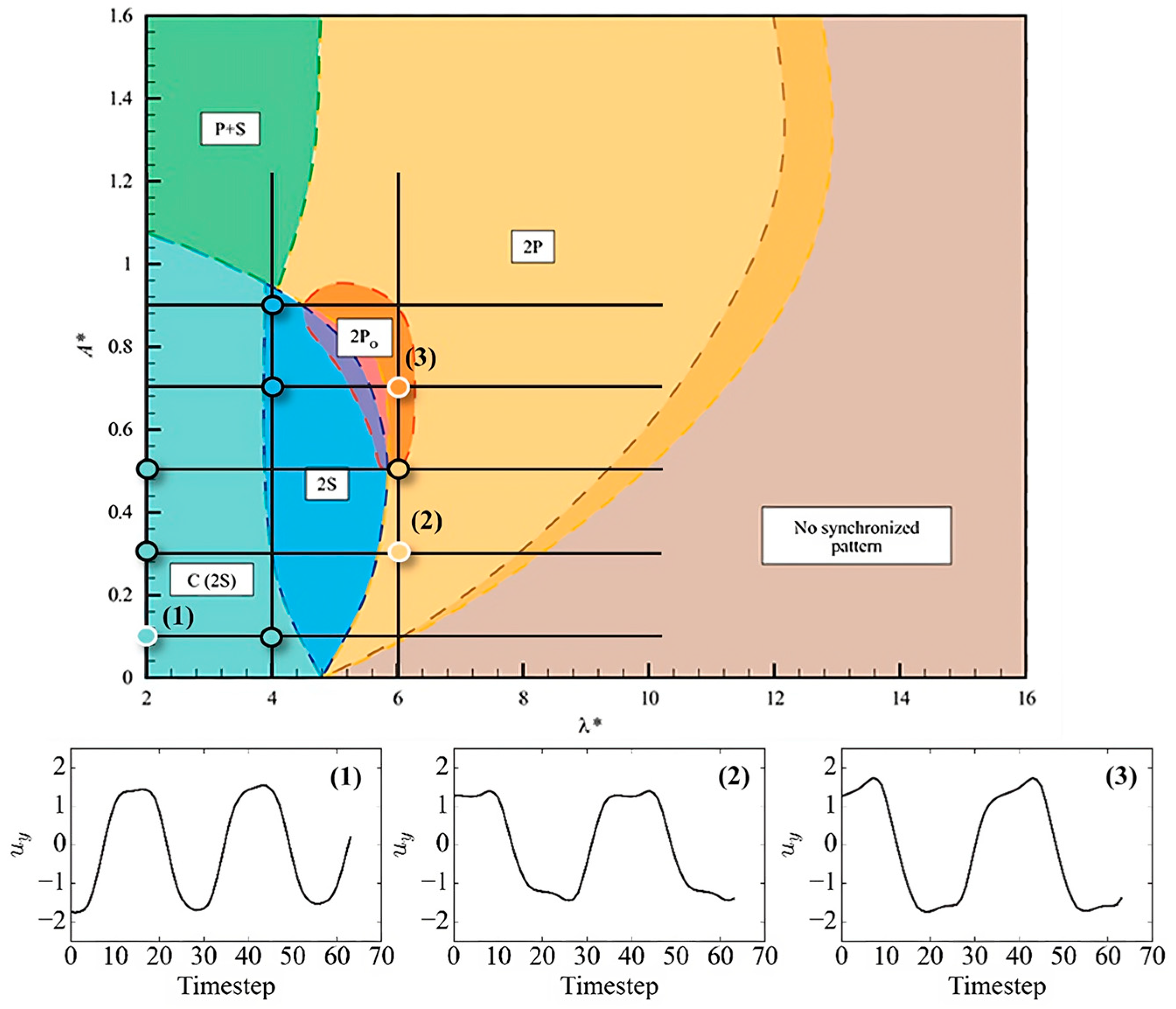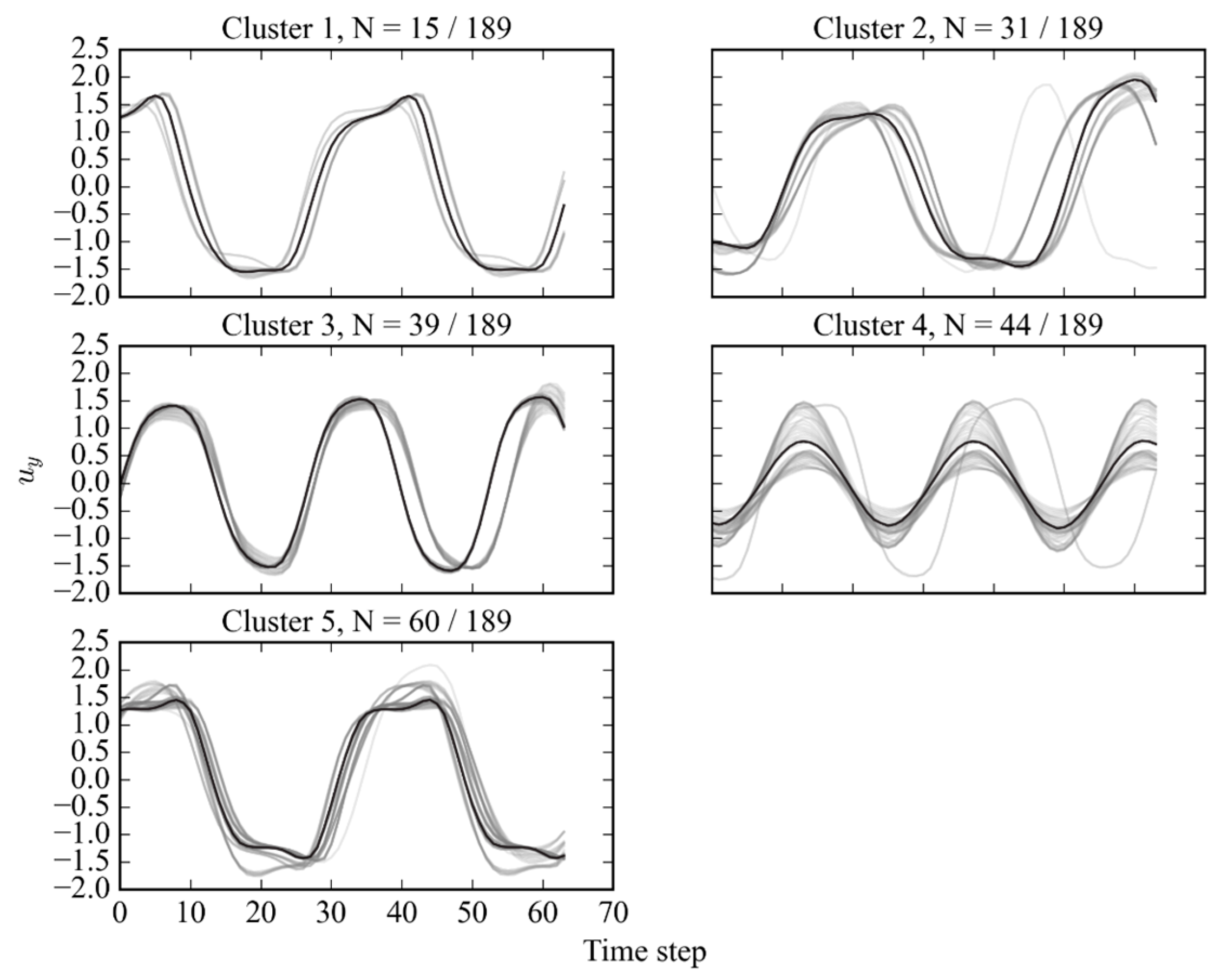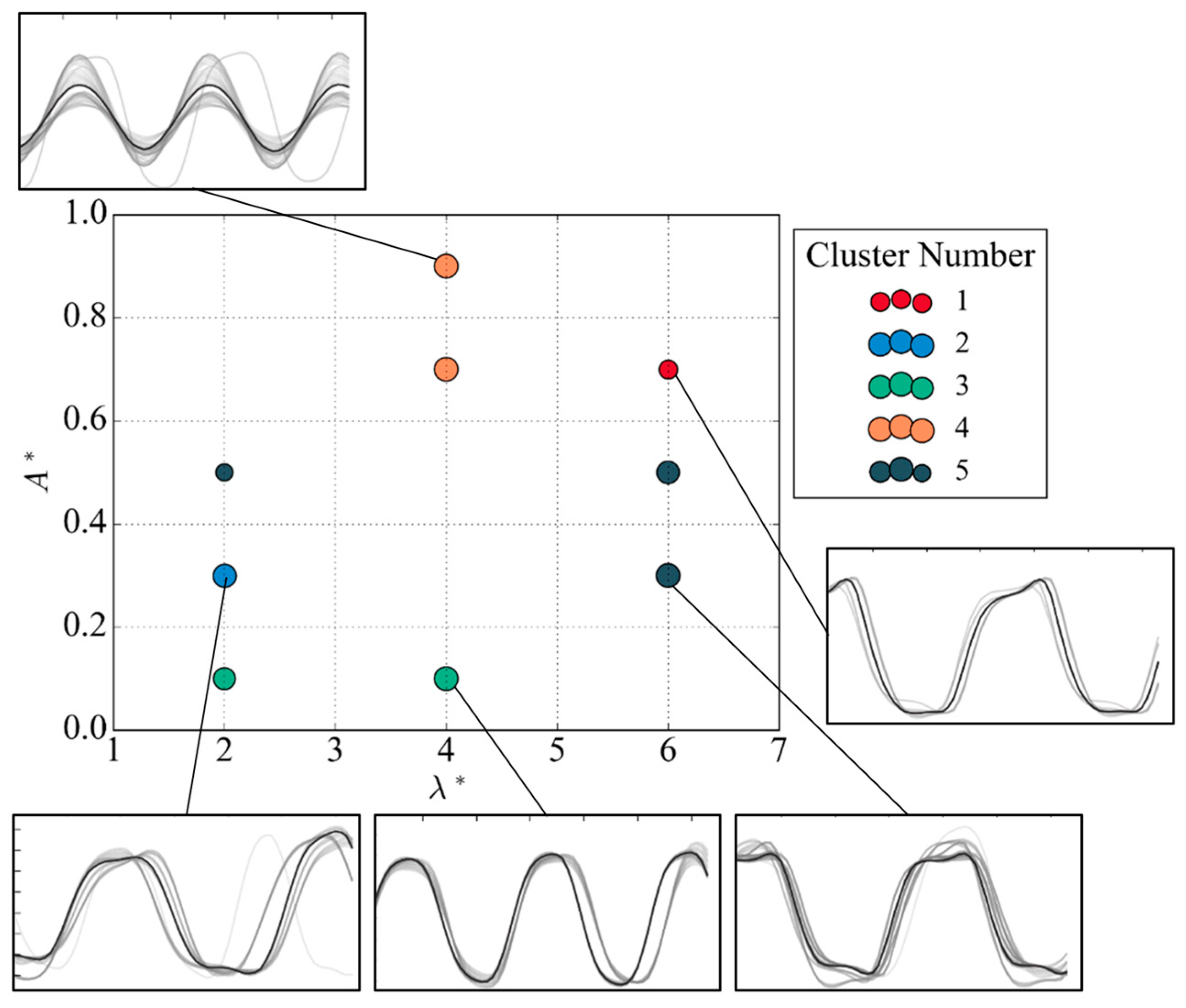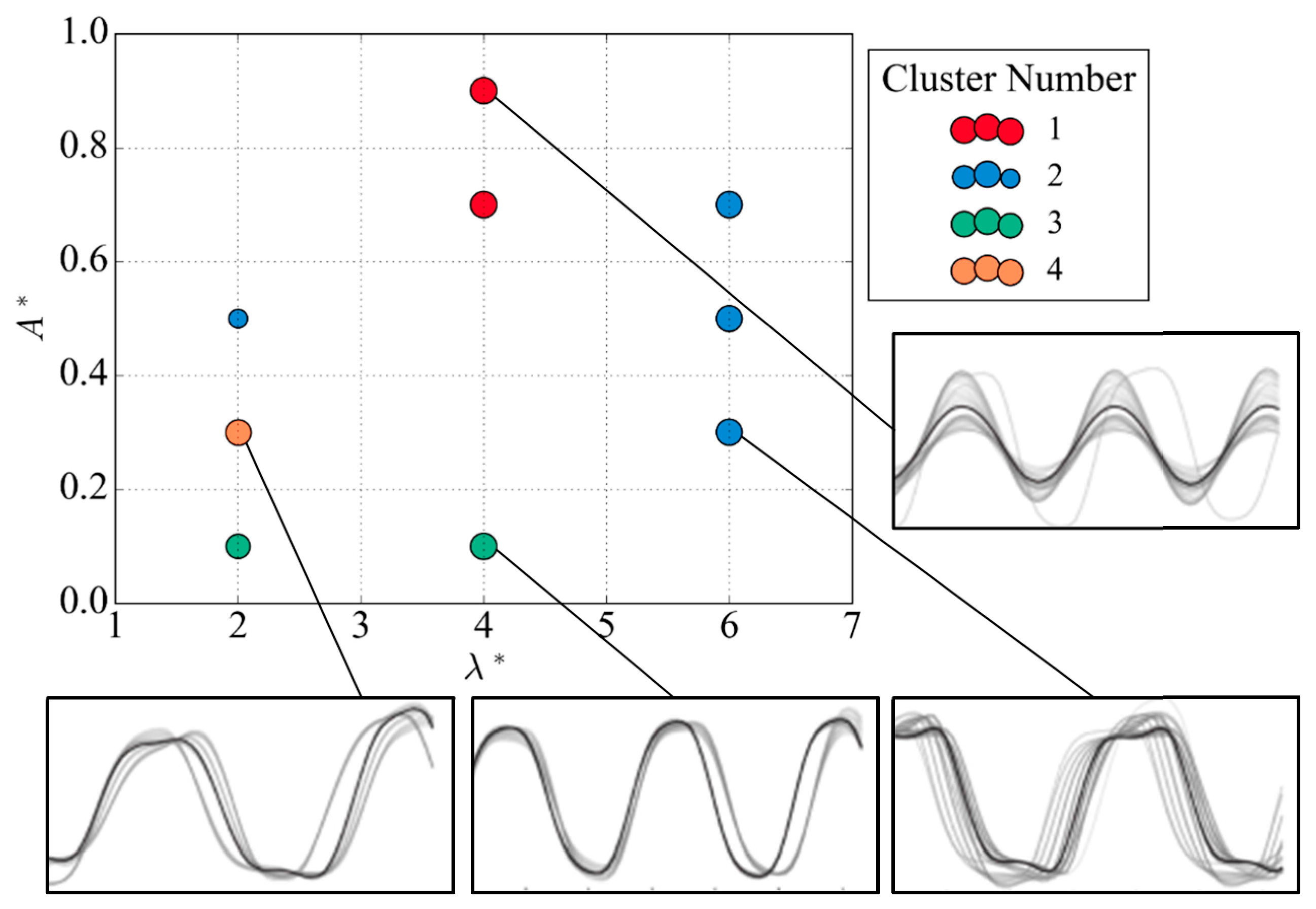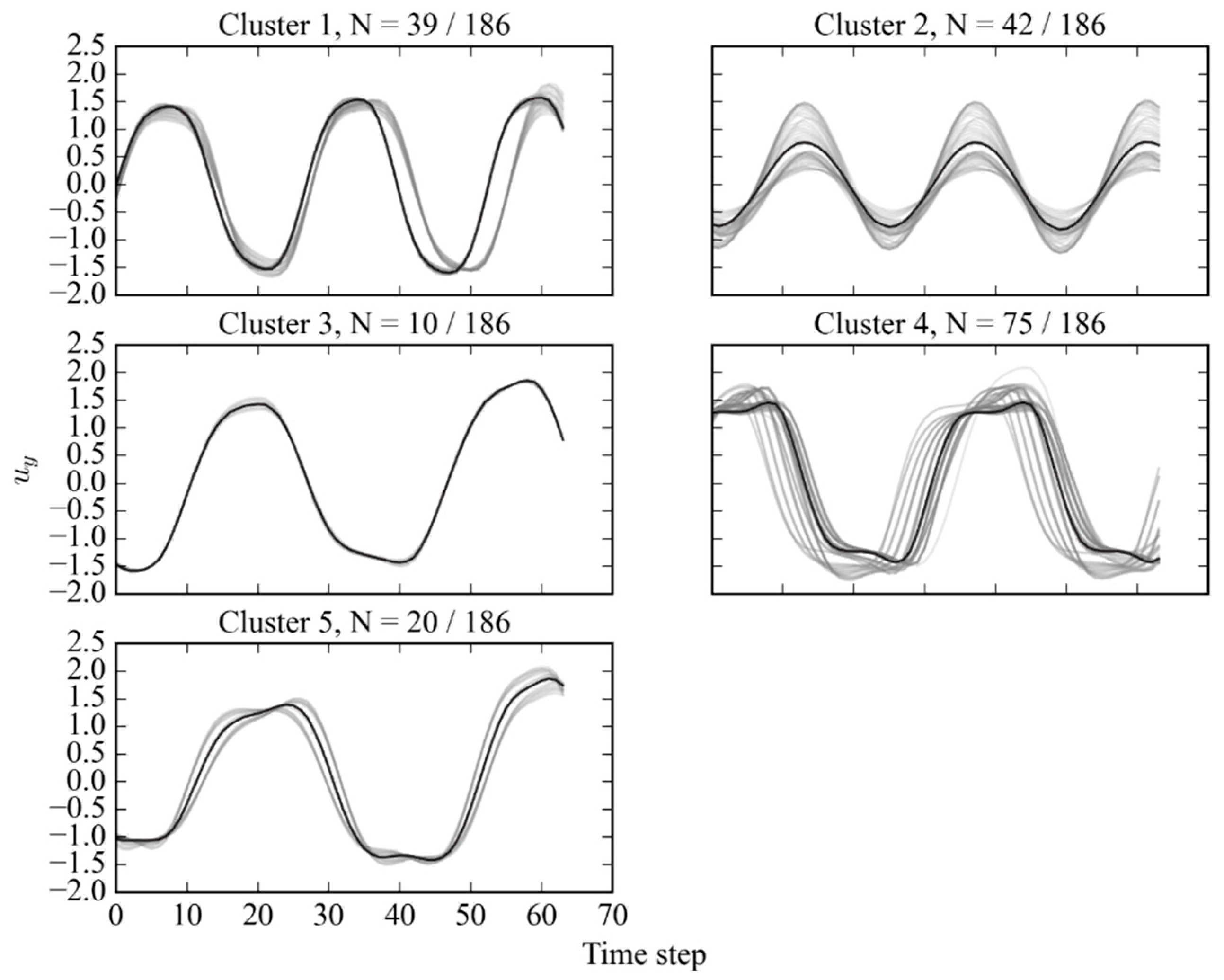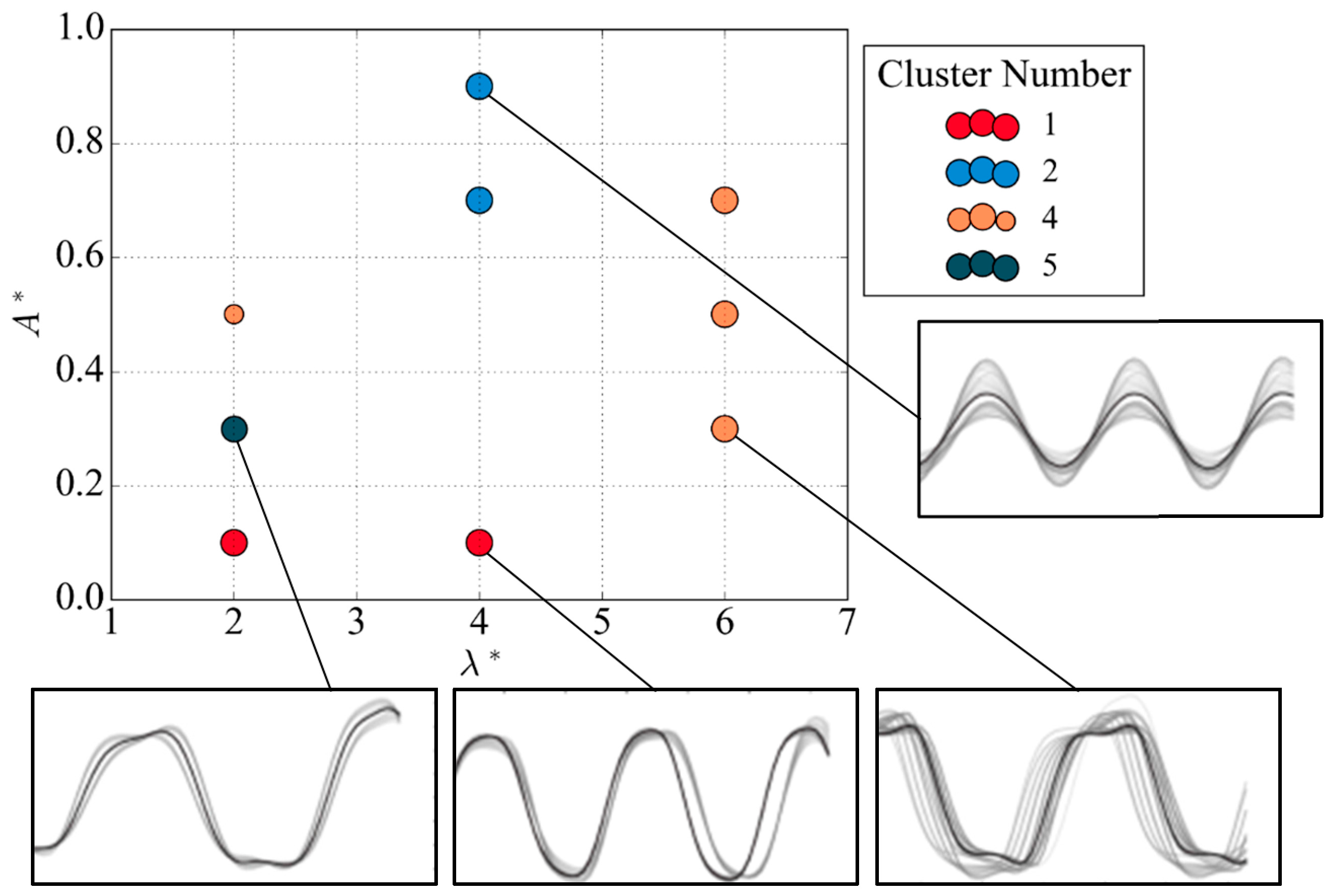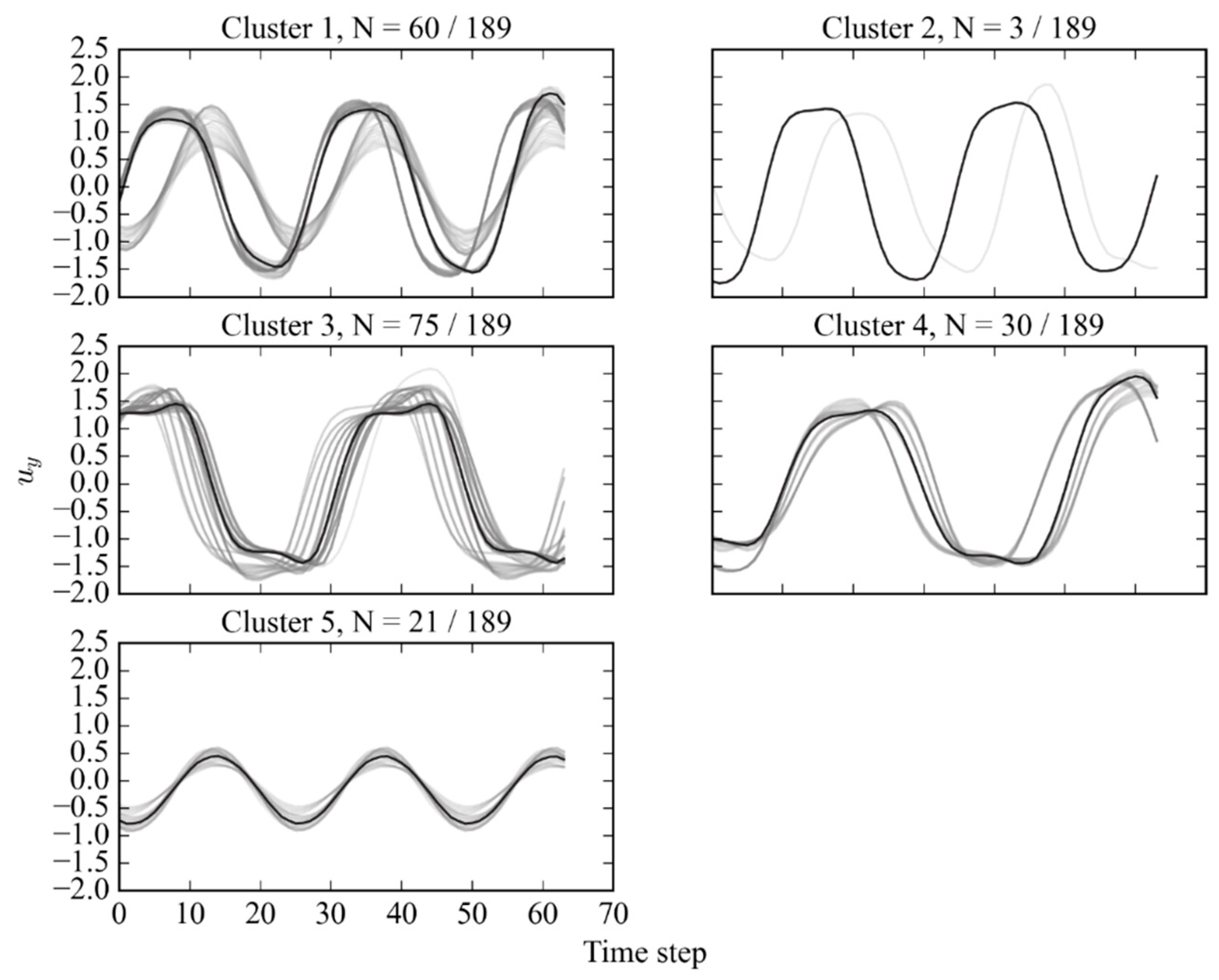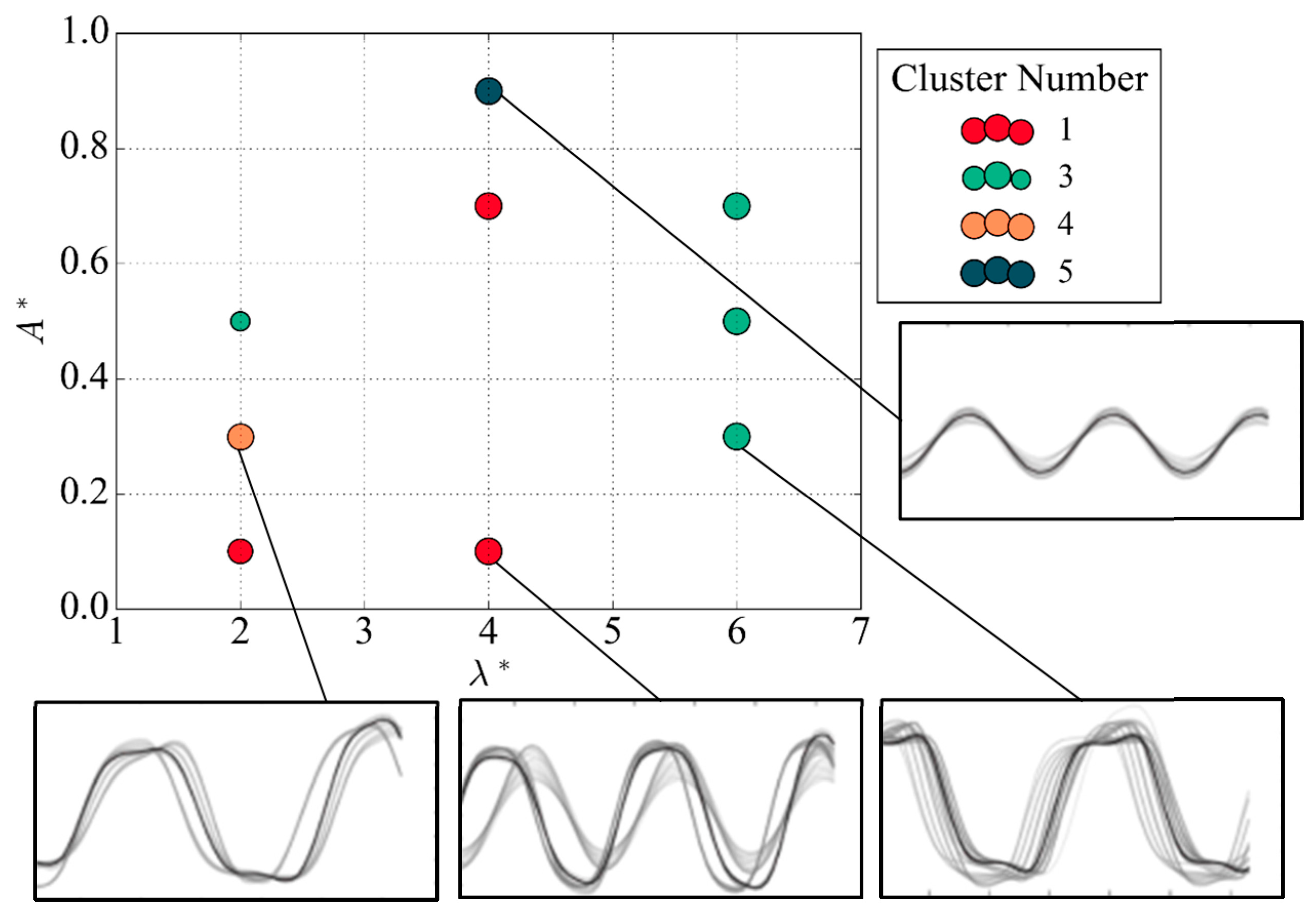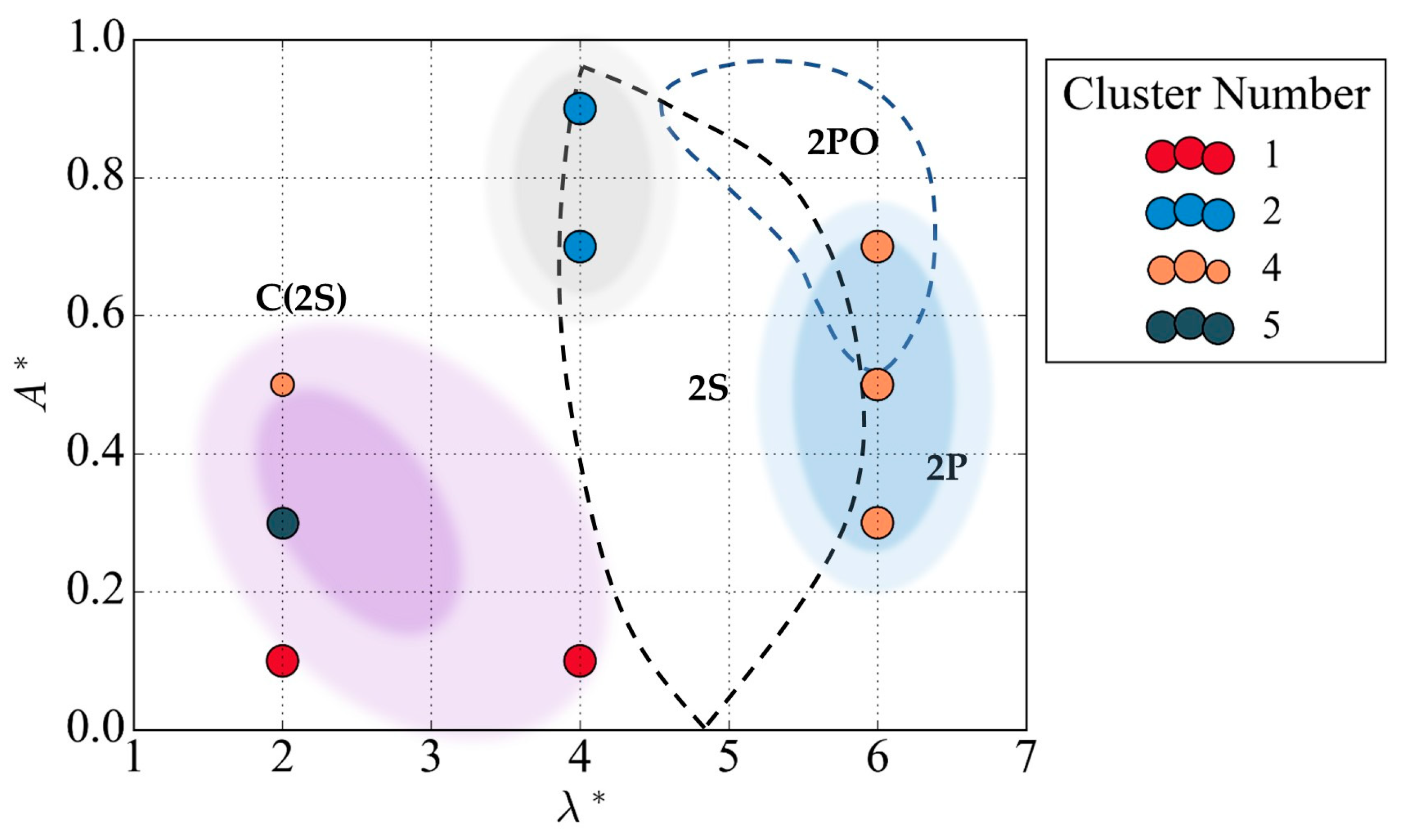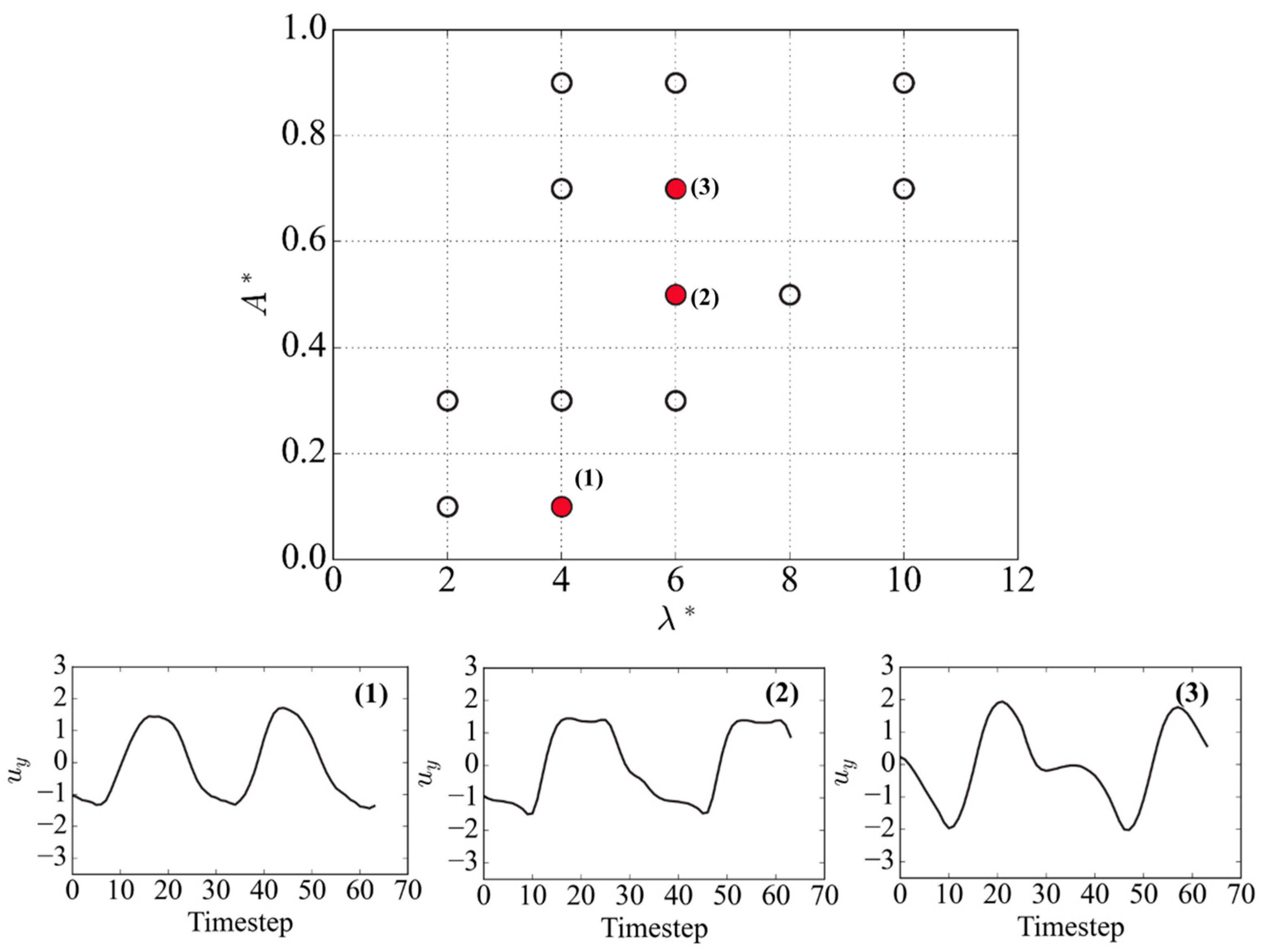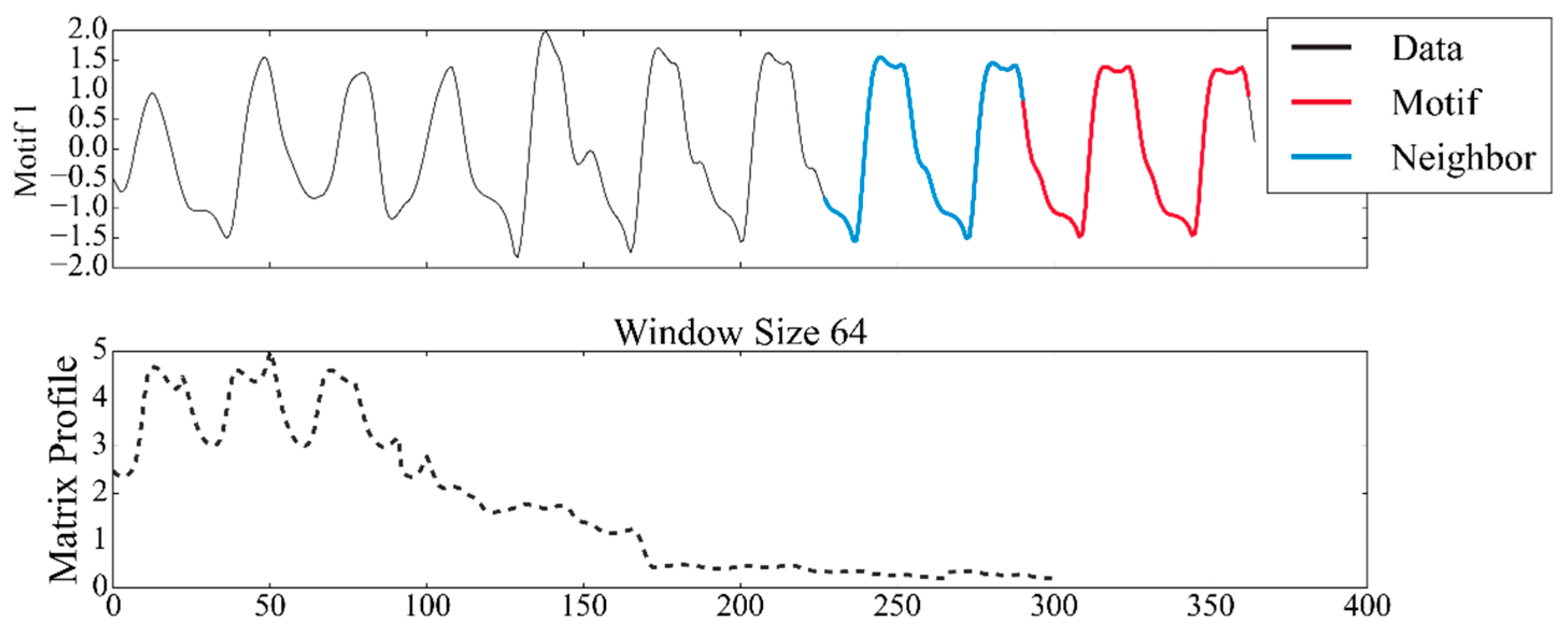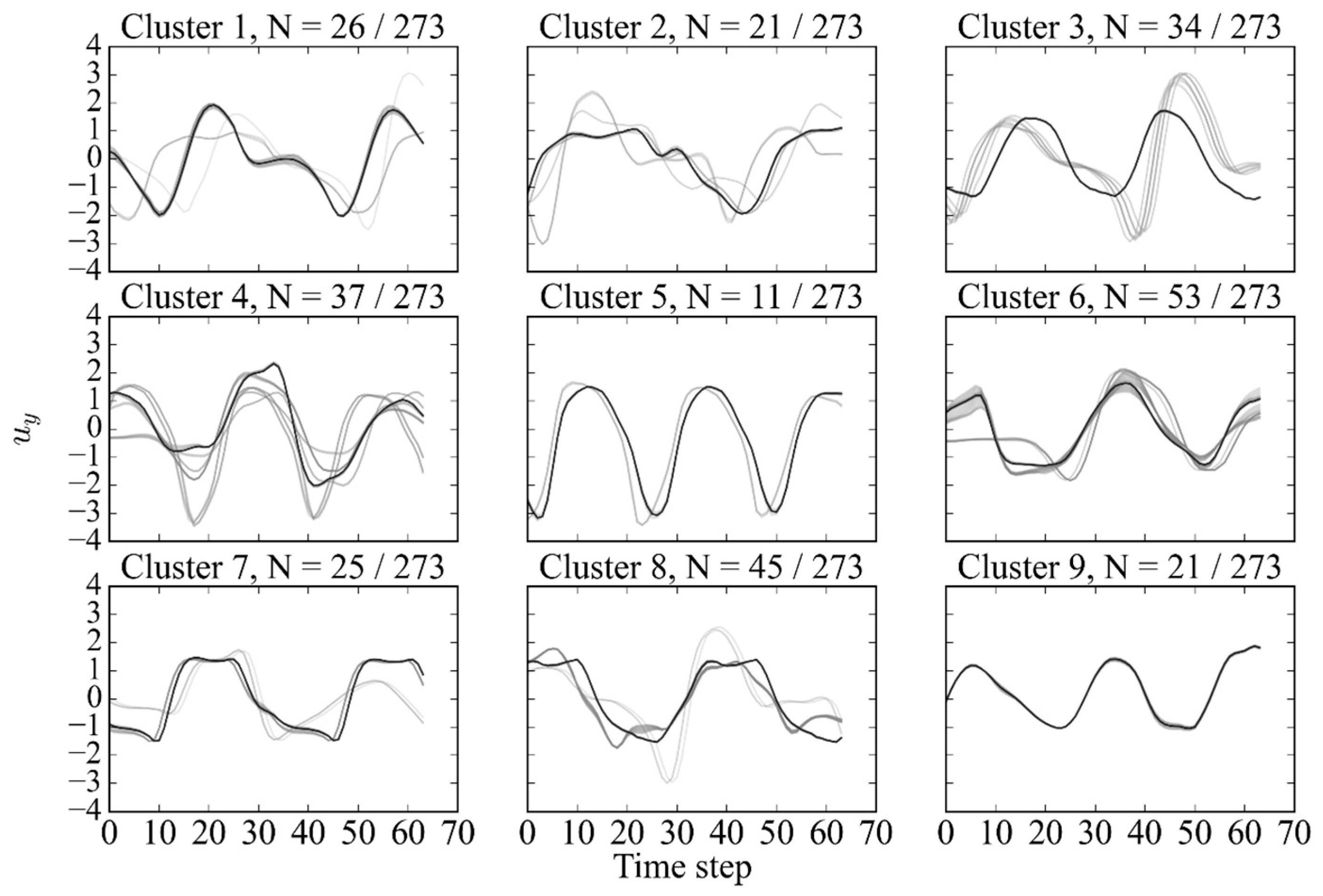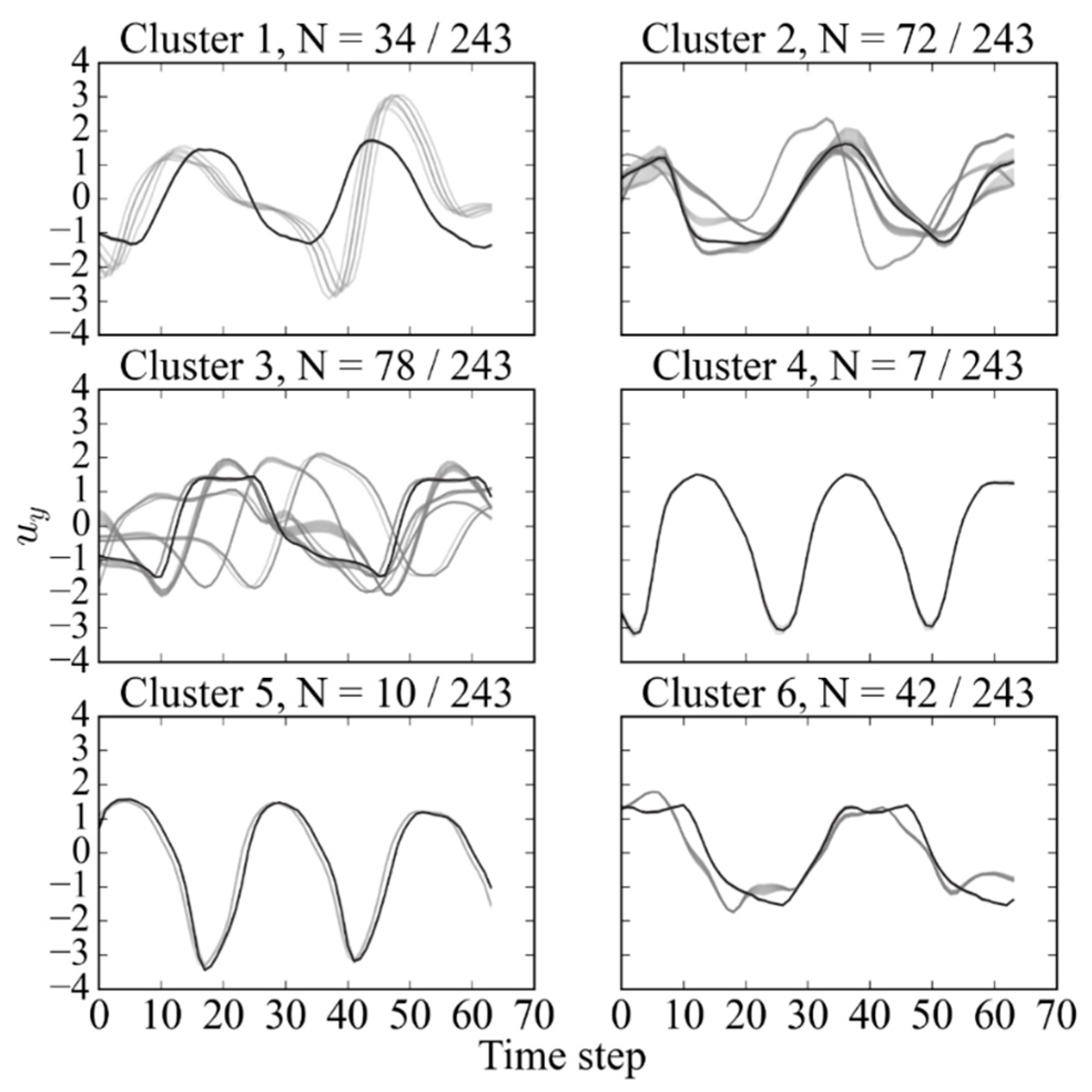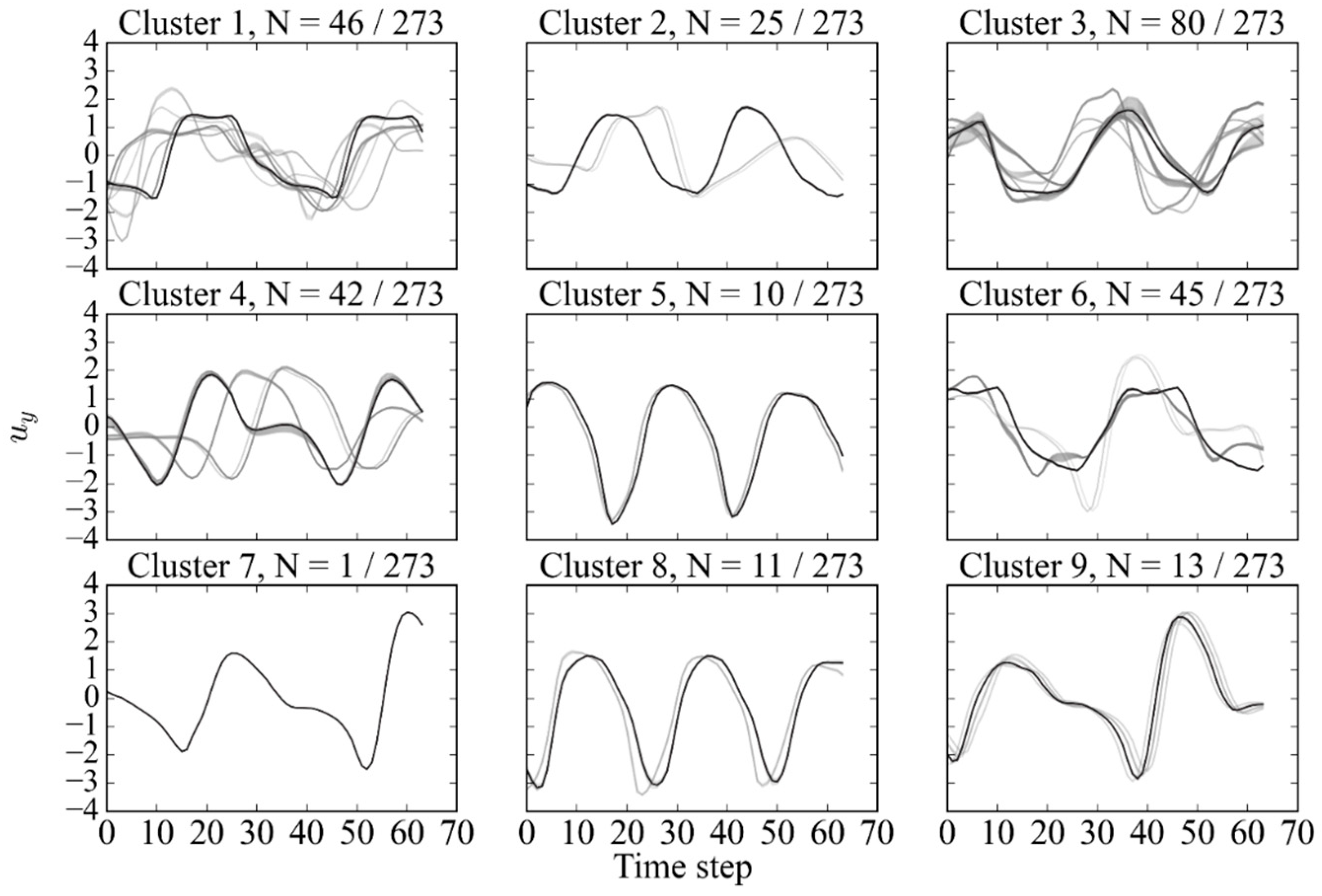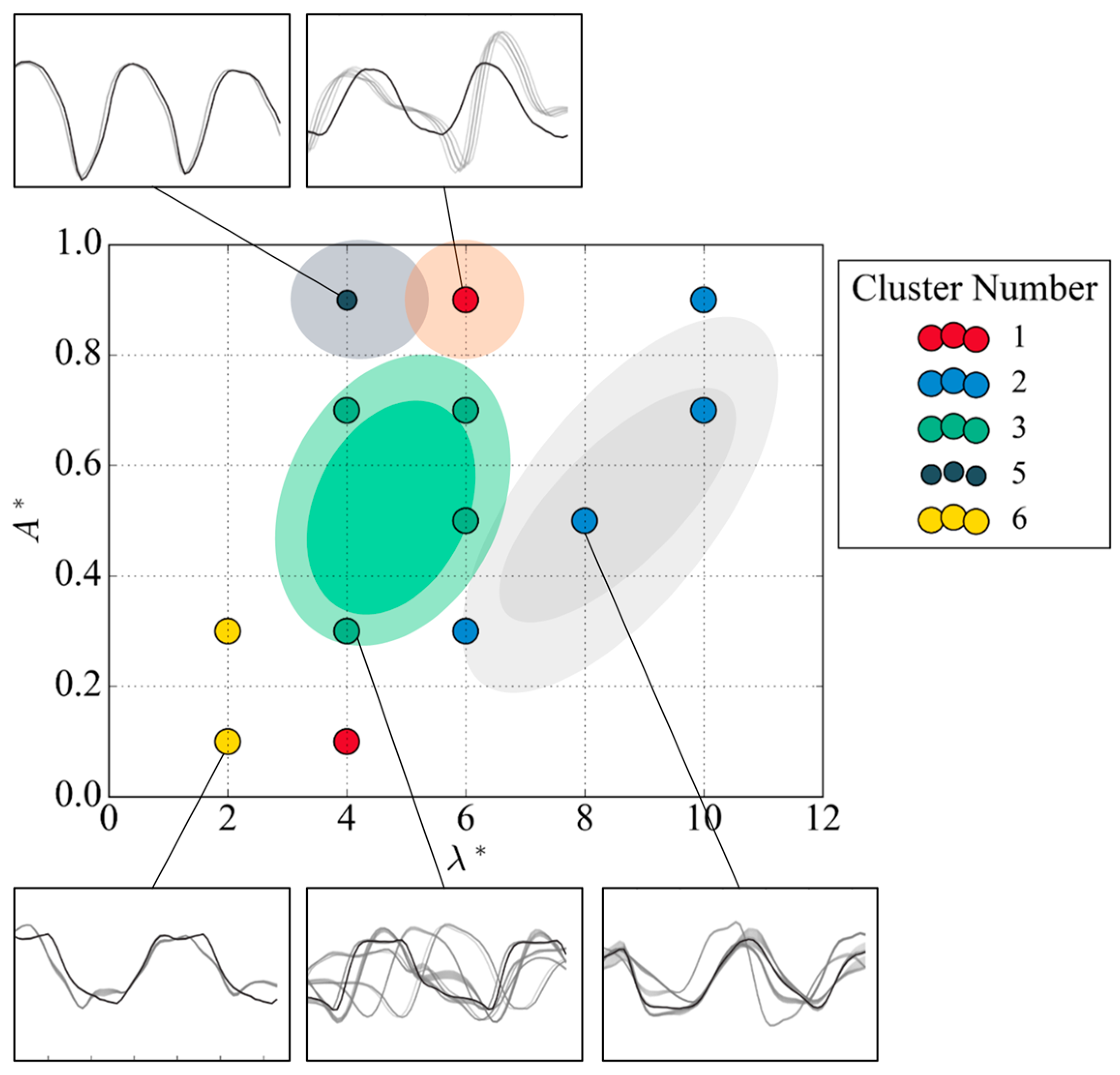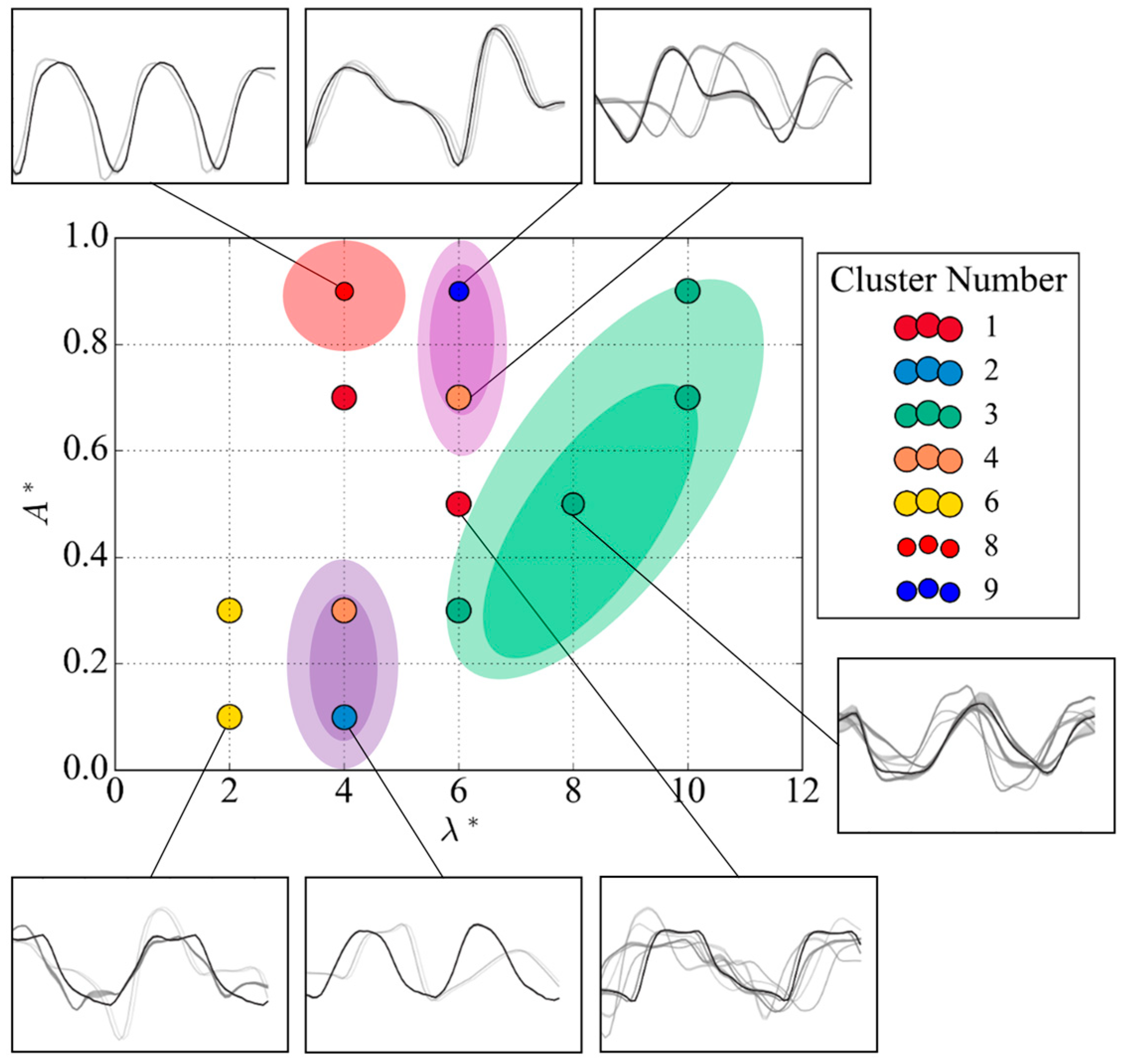Figure 1.
Forced-vibration vortex-shedding map in normalized amplitude–wavelength space [
5].
Figure 1.
Forced-vibration vortex-shedding map in normalized amplitude–wavelength space [
5].
Figure 2.
Domain and boundary conditions used for the 2D simulation (not to scale).
Figure 2.
Domain and boundary conditions used for the 2D simulation (not to scale).
Figure 3.
Matrix profile of (a) example time series and (b) distance profile with a highlighted motif and neighbour (blue trace) identified by minimum distance profile value (red line).
Figure 3.
Matrix profile of (a) example time series and (b) distance profile with a highlighted motif and neighbour (blue trace) identified by minimum distance profile value (red line).
Figure 4.
Block diagram summarizing the key steps in the proposed hybrid algorithm.
Figure 4.
Block diagram summarizing the key steps in the proposed hybrid algorithm.
Figure 5.
Demonstration of the clustering procedure of the full subsequence set and prototype set using varying distance metrics in a two-stage hybrid clustering method.
Figure 5.
Demonstration of the clustering procedure of the full subsequence set and prototype set using varying distance metrics in a two-stage hybrid clustering method.
Figure 6.
Dataset sampled nodes overlaid reference normalized amplitude (
) –wavelength (
) plane [
5], with three subpanels showing example signals extracted from each corresponding node on map, denoted 1, 2, and 3.
Figure 6.
Dataset sampled nodes overlaid reference normalized amplitude (
) –wavelength (
) plane [
5], with three subpanels showing example signals extracted from each corresponding node on map, denoted 1, 2, and 3.
Figure 7.
Subsequence dataset clustered by -Means method at Re = 4000, with representing the number of samples in each cluster relative to the total dataset.
Figure 7.
Subsequence dataset clustered by -Means method at Re = 4000, with representing the number of samples in each cluster relative to the total dataset.
Figure 8.
Vortex-shedding map using -Means method at Re = 4000.
Figure 8.
Vortex-shedding map using -Means method at Re = 4000.
Figure 9.
Subsequence dataset clustered by agglomerative (complete, cosine) method at Re = 4000, with representing the number of samples in each cluster relative to the total dataset.
Figure 9.
Subsequence dataset clustered by agglomerative (complete, cosine) method at Re = 4000, with representing the number of samples in each cluster relative to the total dataset.
Figure 10.
Vortex-shedding map using the agglomerative method at Re = 4000.
Figure 10.
Vortex-shedding map using the agglomerative method at Re = 4000.
Figure 11.
Subsequence dataset clustered by Hybrid A method at Re = 4000, with representing the number of samples in each cluster relative to the total dataset.
Figure 11.
Subsequence dataset clustered by Hybrid A method at Re = 4000, with representing the number of samples in each cluster relative to the total dataset.
Figure 12.
Vortex-shedding map using Hybrid A method at Re = 4000.
Figure 12.
Vortex-shedding map using Hybrid A method at Re = 4000.
Figure 13.
Subsequence dataset clustered by Hybrid B method at Re = 4000, with representing the number of samples in each cluster relative to the total dataset.
Figure 13.
Subsequence dataset clustered by Hybrid B method at Re = 4000, with representing the number of samples in each cluster relative to the total dataset.
Figure 14.
Vortex-shedding map using Hybrid B method at Re = 4000.
Figure 14.
Vortex-shedding map using Hybrid B method at Re = 4000.
Figure 15.
Overlaid benchmark regimes on vortex-shedding map produced with k-Means.
Figure 15.
Overlaid benchmark regimes on vortex-shedding map produced with k-Means.
Figure 16.
Overlaid benchmark regimes on vortex-shedding map produced with agglomerative algorithm.
Figure 16.
Overlaid benchmark regimes on vortex-shedding map produced with agglomerative algorithm.
Figure 17.
Overlaid benchmark regimes on vortex-shedding map produced with Hybrid A.
Figure 17.
Overlaid benchmark regimes on vortex-shedding map produced with Hybrid A.
Figure 18.
Dataset sampled nodes in the normalized amplitude ()–wavelength () plane, with subpanels showing example signals extracted from each corresponding node on the map, denoted 1, 2, and 3.
Figure 18.
Dataset sampled nodes in the normalized amplitude ()–wavelength () plane, with subpanels showing example signals extracted from each corresponding node on the map, denoted 1, 2, and 3.
Figure 19.
Motif extraction for high-Reynolds-number signals of consistent pattern observed at () = (0.5, 6).
Figure 19.
Motif extraction for high-Reynolds-number signals of consistent pattern observed at () = (0.5, 6).
Figure 20.
Subsequence dataset clustered by -Means method at Re = 10,000, with representing the number of samples in each cluster relative to the total dataset.
Figure 20.
Subsequence dataset clustered by -Means method at Re = 10,000, with representing the number of samples in each cluster relative to the total dataset.
Figure 21.
Subsequence dataset clustered by agglomerative (complete, cosine) method at Re = 10,000, with representing the number of samples in each cluster relative to the total dataset.
Figure 21.
Subsequence dataset clustered by agglomerative (complete, cosine) method at Re = 10,000, with representing the number of samples in each cluster relative to the total dataset.
Figure 22.
Subsequence dataset clustered by Hybrid A method at Re = 10,000, with representing the number of samples in each cluster relative to the total dataset.
Figure 22.
Subsequence dataset clustered by Hybrid A method at Re = 10,000, with representing the number of samples in each cluster relative to the total dataset.
Figure 23.
Subsequence dataset clustered by Hybrid B method at Re = 10,000, with representing the number of samples in each cluster relative to the total dataset.
Figure 23.
Subsequence dataset clustered by Hybrid B method at Re = 10,000, with representing the number of samples in each cluster relative to the total dataset.
Figure 24.
Vortex-shedding map regions using the Hybrid A method at Re = 10,000.
Figure 24.
Vortex-shedding map regions using the Hybrid A method at Re = 10,000.
Figure 25.
Vortex-shedding map regions using the Hybrid B method at Re = 10,000.
Figure 25.
Vortex-shedding map regions using the Hybrid B method at Re = 10,000.
Table 1.
Clustering performance metrics of -Means method at Re = 4000.
Table 1.
Clustering performance metrics of -Means method at Re = 4000.
| Clustering Algorithm | Initialization Method | Evaluation Metric |
|---|
| Sil | Dunn |
|---|
| -Means | -Means++ | 0.6559 | 0.15295 |
Table 2.
Clustering performance metrics of agglomerative method at Re = 4000.
Table 2.
Clustering performance metrics of agglomerative method at Re = 4000.
| Clustering Algorithm | Linkage | Affinity Distance | Evaluation Metric |
|---|
| Sil | Dunn |
|---|
| Agglomerative | Complete | Cosine | 0.6794 | 0.61721 |
Table 3.
Clustering performance metrics of Hybrid A method at Re = 4000.
Table 3.
Clustering performance metrics of Hybrid A method at Re = 4000.
| Phase | Clustering Algorithm | Number of Clusters | Evaluation Metric |
|---|
| Sil | Dunn |
|---|
| 1: Pre-Clustering | DBSCAN | 6 (3 Noise Points) | 0.7185 | 0.36049 |
| 2: Final Clustering | Agglomerative | 5 | 0.7031 | 0.39836 |
Table 4.
Clustering performance metrics of Hybrid B method at Re = 4000.
Table 4.
Clustering performance metrics of Hybrid B method at Re = 4000.
| Phase | Clustering Algorithm | Clusters | Evaluation Metric |
|---|
| Sil | Dunn |
|---|
| Pre-Clustering | -Means | 20 | 0.7464 | 0.09175 |
| Final Clustering | Agglomerative | 5 | 0.5336 | 0.11211 |
Table 5.
Final clustering performance metrics of proposed methods at Re = 4000.
Table 5.
Final clustering performance metrics of proposed methods at Re = 4000.
| Type | Clustering Algorithm | Representation Method | Evaluation Metric |
|---|
| Sil | Dunn |
|---|
| Partitioning | -Means | Raw Time Series | 0.6559 | 0.15295 |
| Hierarchical | Agglomerative | Raw Time Series | 0.6794 | 0.61721 |
| Hybrid | DBSCAN/Agglomerative | Raw Time Series | 0.7031 | 0.39836 |
| Hybrid | -Means/Agglomerative | Raw Time Series | 0.5336 | 0.11211 |
Table 6.
Clustering performance metrics of -Means method at Re = 10,000.
Table 6.
Clustering performance metrics of -Means method at Re = 10,000.
| Clustering Algorithm | Evaluation Metric |
|---|
| Sil | Dunn |
|---|
| -Means | 0.5750 | 0.49261 |
Table 7.
Clustering performance metrics of agglomerative method at Re = 10,000.
Table 7.
Clustering performance metrics of agglomerative method at Re = 10,000.
| Clustering Algorithm | Evaluation Metric |
|---|
| Sil | Dunn |
|---|
| Agglomerative | 0.5760 | 0.51160 |
Table 8.
Clustering performance metrics of Hybrid A method at Re = 10,000.
Table 8.
Clustering performance metrics of Hybrid A method at Re = 10,000.
| Phase | Clustering Algorithm | Clusters | Evaluation Metric |
|---|
| Sil | Dunn |
|---|
| Pre-Clustering | DBSCAN | 14 (30 Noise) | 0.7250 | 0.20279 |
| Final Clustering | Agglomerative | 6 | 0.4822 | 0.31561 |
Table 9.
Clustering performance metrics of Hybrid B method at Re = 10,000.
Table 9.
Clustering performance metrics of Hybrid B method at Re = 10,000.
| Phase | Clustering Algorithm | Clusters | Evaluation Metric |
|---|
| Sil | Dunn |
|---|
| Pre-Clustering | -Means | 30 | 0.8693 | 0.05395 |
| Final Clustering | Agglomerative | 9 | 0.4694 | 0.28585 |
Table 10.
Final clustering performance metrics of proposed methods at Re = 10,000.
Table 10.
Final clustering performance metrics of proposed methods at Re = 10,000.
| Type | Clustering Algorithm | Evaluation Metric |
|---|
| Sil | Dunn |
|---|
| Partitioning | -Means | 0.5750 | 0.49261 |
| Hierarchical | Agglomerative | 0.5760 | 0.51160 |
| Hybrid A | DBSCAN/Agglomerative | 0.4822 | 0.31561 |
| Hybrid B | -Means/Agglomerative | 0.4694 | 0.28585 |
